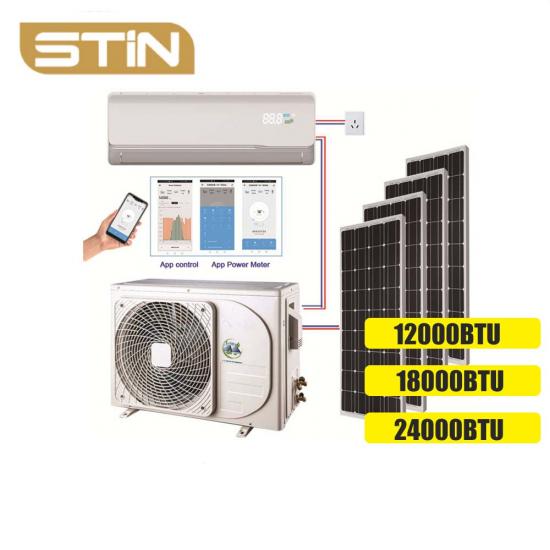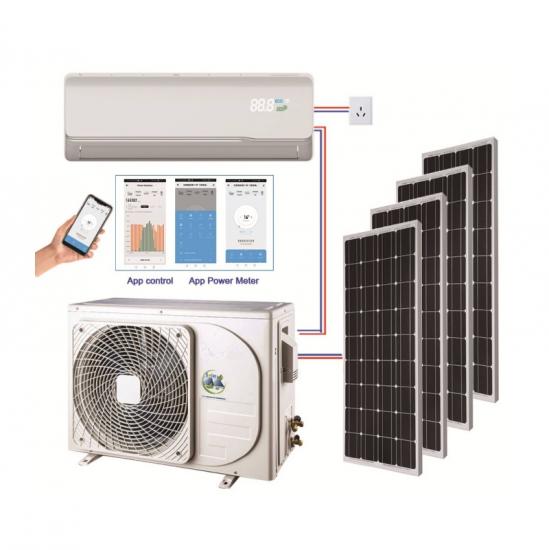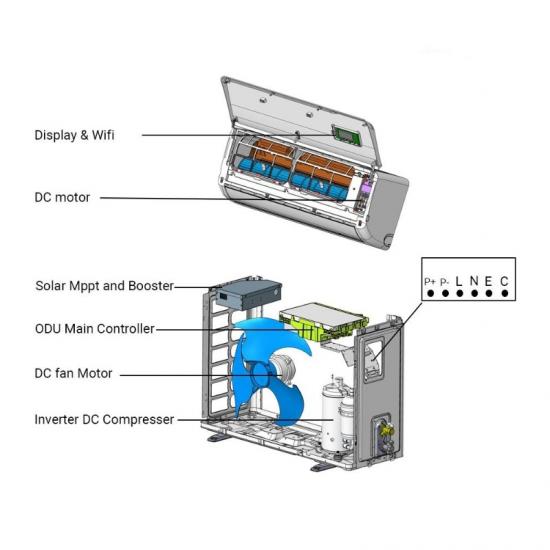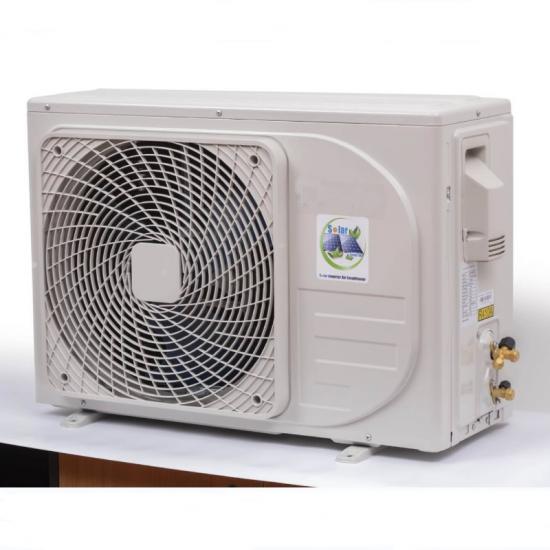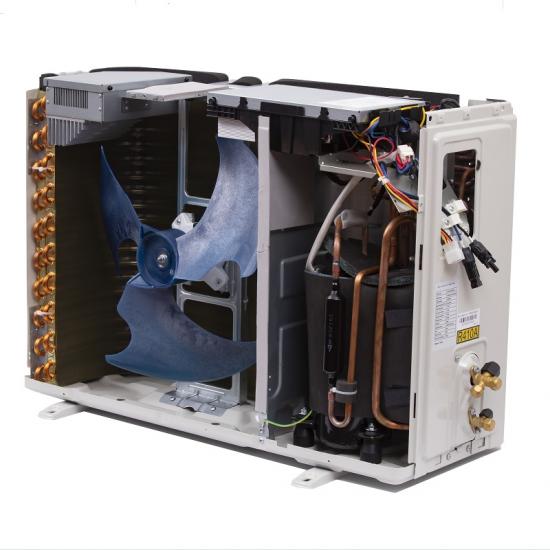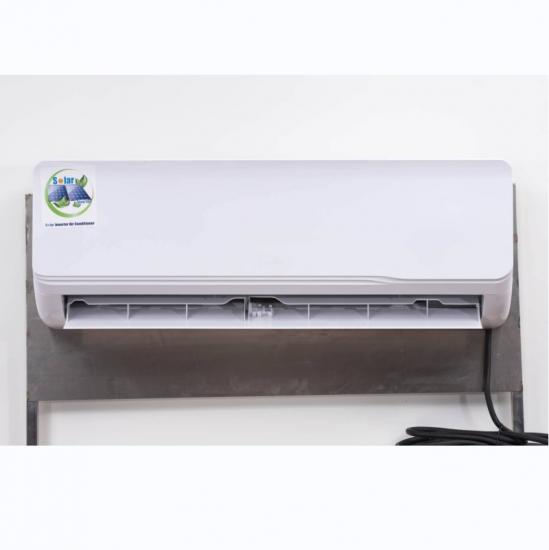At night or rainy days it automatically get grid AC power. It's mainly used for school classroom, hospital, restaurant, shops, office…
With APP monitor and control function through WIFI
Payment:
TT/LC/PAYPAL/WESTUNIONProduct Origin:
ChinaShipping Port:
Shanghai/Ningbo/ShenzhenLead Time:
15daysOrder(MOQ):
1Our ACDC Hybrid Solar Air Conditioner system is designed to use solar. When the grid voltage low to 165v, our systemcan still work well. Besides the compressor and control circuit, all the main components are DC powered, like highefficient DC fan motor, compressor and electronic expansion valve.There are several sensors in the system detect the circuit, control the refrigerant flow volume through the electronicexpansion valve, thus achieve perfect combination of intelligent refrigerant flow and inverter technology, raise or lowerthe air conditioner’s cooling/heating capacity according to the actual conditions. The inverter controller managecompressor running speed, refrigerant flow volume and fan speed etc, these all can be managed throuah the severasensors detect the circuit, and adiust automatically according to the actual conditions. When the room temp. isapproached to the setting temp, the system will automatically lower its capacity and power consumption, so theinverter Variable Refrigerant Flow (RF) technology itself can save 40% -50% compared to the regular air conditioner.
Specification of solar air conditioner
| Model | Unit | ACDCBLW-12K | ACDCBLW-18K | ACDCBLW-24K | |
| Climate Type | Tropical</= 58ºC |
|
T3/T1 | T3/T1 | T3/T1 |
| Application area | m2 | 12-20 | 20-30 | 30-42 | |
|
Power Supply |
AC Power | Ph-V-Hz | 1Ph 208V-240V/50-60HZ | 1Ph 208V-240V/50-60HZ | 1Ph 208V-240V/50-60HZ |
| DC Power (PV in Series) | V | 80-380V | 80-380V | 80-380V | |
| DC Power Current | A | </=10A | </=10A | </=10A | |
| Adviced Solar Panel | Pcs | (3-4)*330W in series | (3-6)*330W in series | (3-8)*330W in series | |
|
Rated Cooling |
Capacity(T1) |
W | 3510(900-3900) | 5070(1200-6000) | 6450(1800-7900) |
| BTU | 12000(3000-13300) | 17300(4100-20400) | 22000(6100-27000) | ||
| Power input(T1) | W | 940(190-1270) | 1400(220-2100) | 1790(300-3200) | |
|
Capacity(T3) |
W | 2910 | 4290 | 5130 | |
| BTU | 9900 | 14700 | 17500 | ||
| Power input(T3) | W | 1050 | 1630 | 1940 | |
|
Rated Heating |
Capacity |
W | 4100(1000-4500) | 6100(1200-6800) | 7800(1800-9100) |
| BTU | 14000(3000-15300) | 20800(4100-23000) | 26600(6100-31000) | ||
| Power input | W | 1170(190-1700) | 1770(220-2500) | 2290(300-3500) | |
| T1 EER (W/W)/ (BTU/W) | / | 3.75/12.75 | 3.60/12.35 | 3.60/12.30 | |
| T3 EER (W/W)/ (BTU/W) | / | 2.75/9.45 | 2.65/9.00 | 2.65/9.00 | |
| COP (W/W)/ (BTU/W) | / | 3.50/11.95 | 3.45/11.75 | 3.40/11.60 | |
| Dehumidification capacity | L/h | 1.3 | 1.7 | 2.5 | |
|
Compressor |
Model | / | WHP04200 | WHP05600 | 5RD198 |
| Type | / | 2xRotary Inverter | 2xRotary Inverter | 2xRotary Inverter | |
|
Indoor fan motor |
Model |
|
BLDC-15W | BLDC-45W | BLDC-45W |
| Speed(Turbo/Hi/Mi/Lo) | r/min | 1300/1200/1100/950 | 1050/950/850/750 | 1350/1250/1150/1000 | |
| Indoor air flow(Turbo/Hi/Mi/Lo) | m3/h | 540/485/435/350 | 980/880/740/620 | 1290/1180/1070/900 | |
| Indoor noise level (Turbo) | dB(A) | ≤42.5 | ≤46 | ≤50 | |
|
Indoor unit |
Dimension(W×H×D) | mm | 840×205×295 | 1080×330×237 | 1080×330×237 |
| Packing (W×H×D) | mm | 920×290×360 | 1140×300×382 | 1140×300×382 | |
| Net weight/Gross weight | Kg | 9.0/12.5 | 15.0/18.5 | 15.0/18.5 | |
|
Outdoor fan motor |
Model | / | BLDC-40W | BLDC-55W | BLDC-75W |
| Speed | r/min | 880 | 880 | 850 | |
| Outdoor air flow | m3/h | 2100 | 2200 | 3300 | |
| Outdoor noise level | dB(A) | ≤52 | ≤55 | ≤58 | |
|
Outdoor unit |
Dimension(W×H×D) | mm | 802×564×323 | 802×564×323 | 900×700×337 |
| Packing (W×H×D) | mm | 910×622×405 | 910×622×405 | 1006×755×418 | |
| Net/Gross weight | Kg | 33.5/37.5 | 37/42.0 | 50/54.5 | |
| Refrigerant type | / | R410A | R410A | R410A | |
| Max Design pressure | MPa | 4.3/1.5 | 4.3/1.5 | 4.3/1.5 | |
|
Refrigerant copper pipe |
Gas side/Liquid side (inch) | inch | 3/8 1/4 | 1/2 1/4 | 1/2 1/4 |
| Max. refrigerant pipe length | m | 15 | 20 | 25 | |
| Max. difference in level | m | 8 | 10 | 10 | |
| Drain pipe size | mm | 16 | 16 | 16 | |
| Refrigerant connction copper pipe length | m | 3 | 4 | 4 | |
| Connection wire length | m | 4 | 5 | 5 | |
| Electronic Expansion Valve | / | Yes | Yes | Yes | |
| Loading QTY 40" Hq/ 20"GP | Sets | 200/85 | 160/75 | 115/50 | |
Solar panel and system installation
Below is the design how our solar power system should be installed. If you want to use solar air conditioner only in day time (approximate from 7:00am to 17:00pm), then no need to install grid power to our system. If you want to ran at night with electricity or generator or youwant to work mix power to get best cooling in heavy cloudy days you can install grid power part for 24hour working.
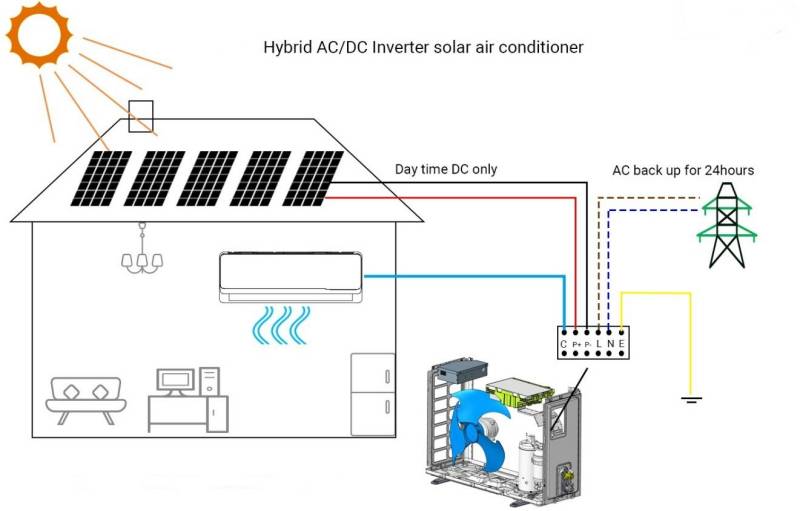
Solar panel choosing
STIN hybrid ACDC solar air conditioners unit suit for both Poly and mono solar panel on the market from 250w to 450w. But all the solar panel should be in series connection, parallel is not allowed.
|
Model |
Capacity |
Solar DC voltage |
DC Current |
Input Power request |
|
DGWA1-ACDCBLW-12K WiFi |
12000btu 1.5HP 1Ton |
80V-380V |
</=10A |
940(190-1270) W |
|
DGWA1-ACDCBLW-18K WiFi |
18000btu 2.0Hp 1.5Ton |
80V-380V |
</=10A |
1400(220-2100) W |
|
DGWA1-ACDCBLW-24K WiFi |
24000btu 3.0Hp 2.0Ton |
80V-380V |
</=10A |
1790(300-3200) W |
WiFi control and APP power meter
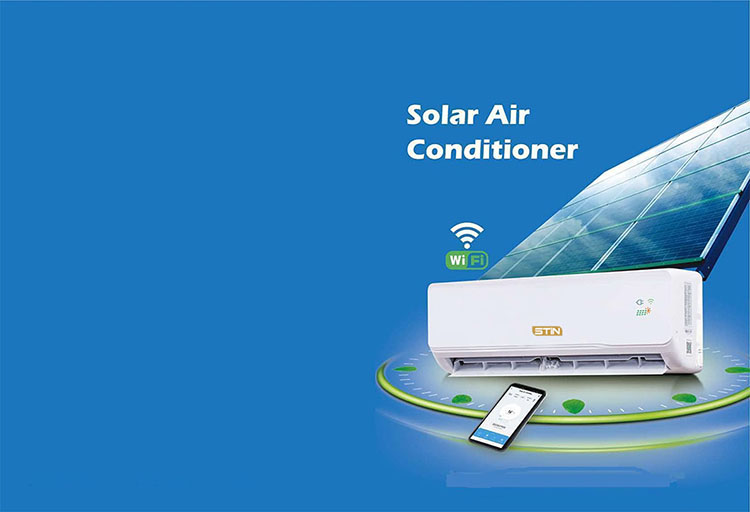
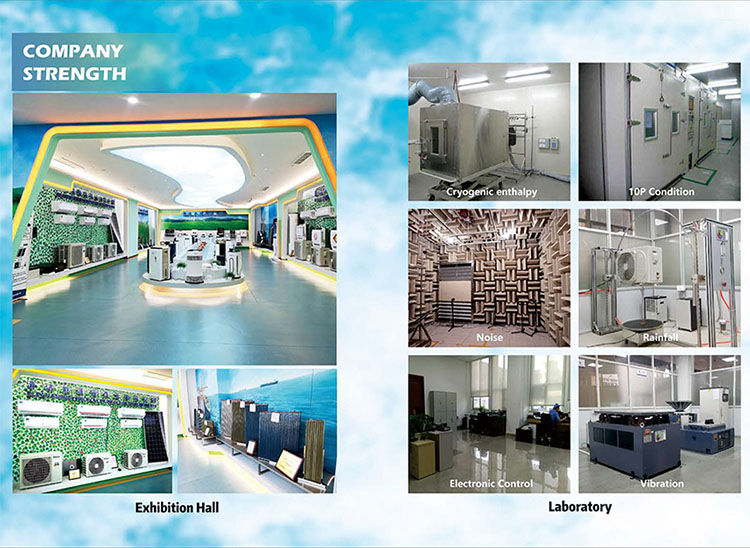
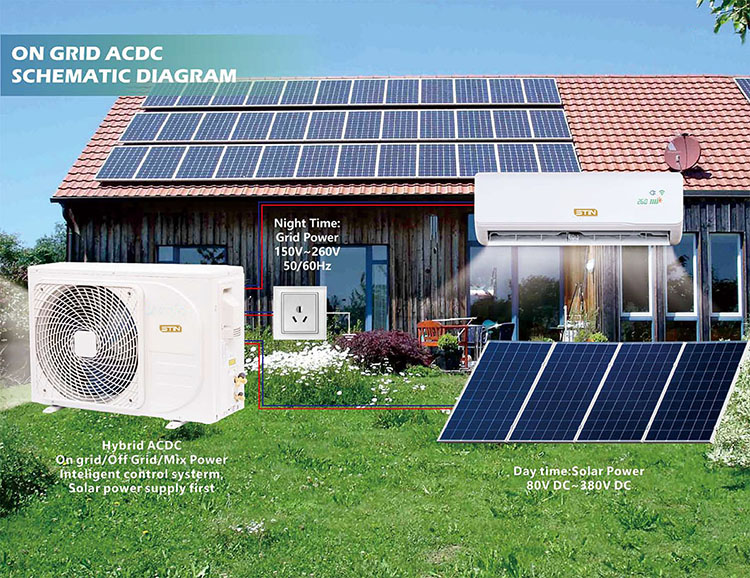
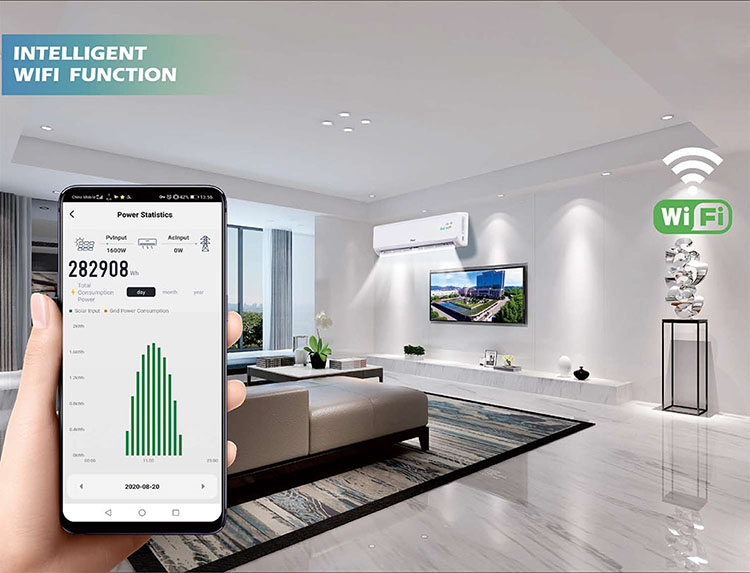
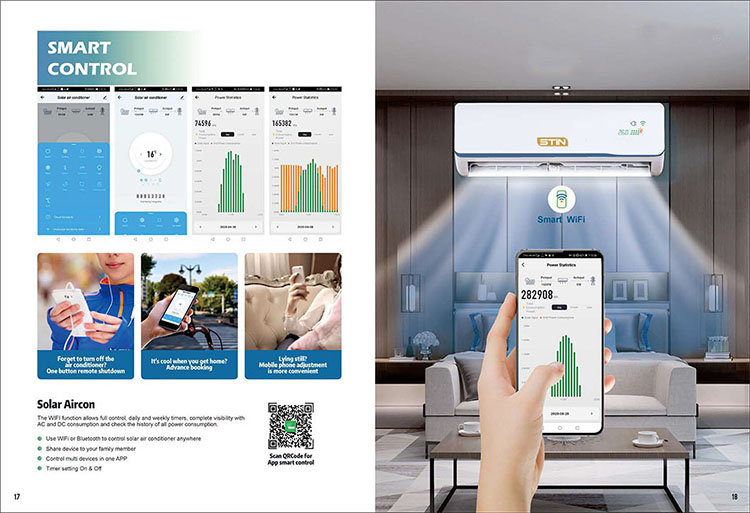
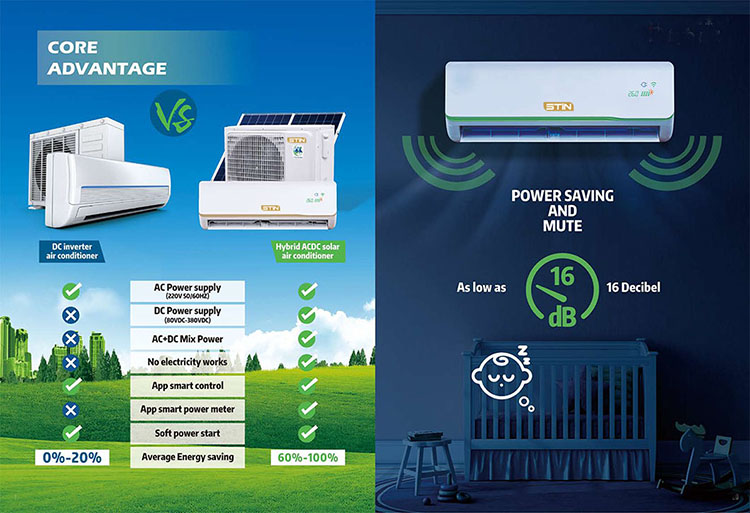
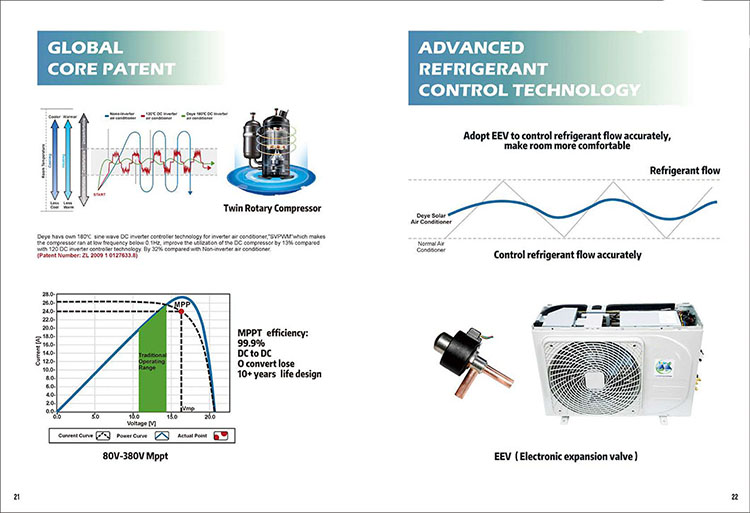
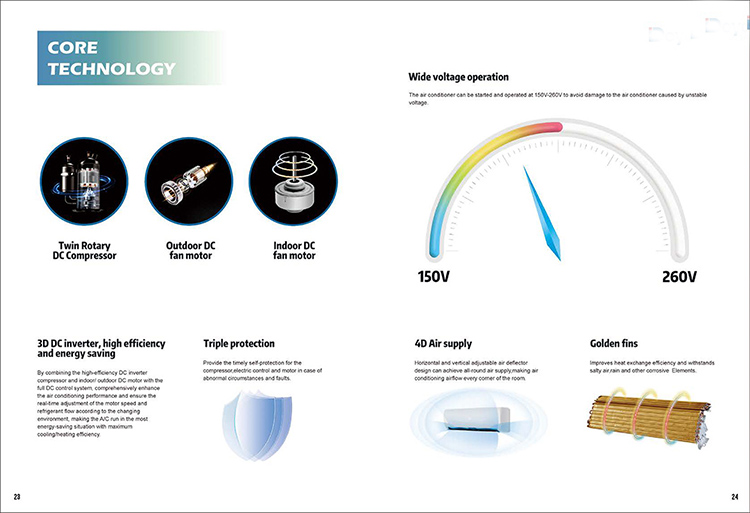
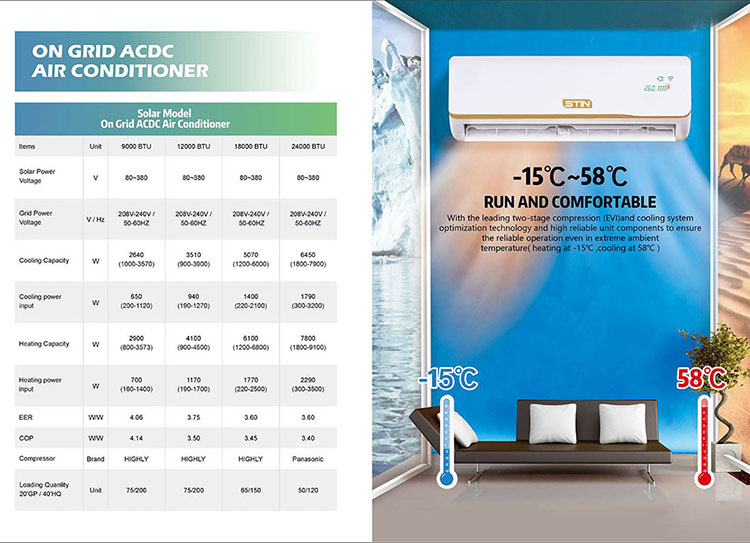
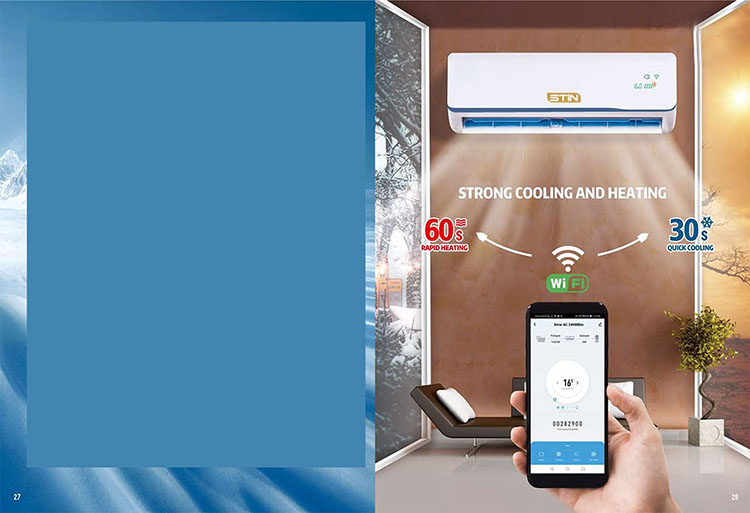
The solar hybrid AC/DC air conditioner can work without battery, it works with unstable solar panel DC power at day time. At night or rainy days it automatically get grid AC power. It's mainly used for school classroom, hospital, restaurant, shops, office… With APP monitor and control function through WIFI
The solar Multi-split hybrid AC/DC air conditioner can work without battery, it works with unstable solar panel DC power at day time. At night or rainy days it automatically get grid AC power. It's mainly used for school classroom, hospital, restaurant, shops, office… With APP monitor and control function through WIFI
The solar hybrid AC/DC air conditioner can work without battery, it works with unstable solar panel DC power at day time. At night or rainy days it automatically get grid AC power. It's mainly used for school classroom, hospital, restaurant, shops, office… With APP monitor and control function through WIFI
The solar hybrid AC/DC air conditioner can work without battery, it works with unstable solar panel DC power at day time. At night or rainy days it automatically get grid AC power. It's mainly used for school classroom, hospital, restaurant, shops, office… With APP monitor and control function through WIFI
The solar hybrid AC/DC air conditioner can work without battery, it works with unstable solar panel DC power at day time. At night or rainy days it automatically get grid AC power. It's mainly used for school classroom, hospital, restaurant, shops, office… With APP monitor and control function through WIFI
The 5kw solar inverter is integrated with MPPT solar charge controller inside. It can also connect to grid to take grid as backup when battery is over discharged. The output voltage is 220V, maximum 6pcs in parallel. 3pcs in parallel can get three phase 380v output. All of parameter such as working mode, charging current, over discharge voltage can be set as you wish.
The charger is an AC to DC charging module. It has the advantages of wide constant power voltage range, high efficiency, high power factor, high power density, minimal electromagnetic radiation and interference, and high reliability to meet the fast charging needs of various batteries. ,Energy saving and environmental protection.
This high voltage lifepo4 battery system is composed of high quality lithium iron phosphate core (series-parallel connection) and advanced BMS management system.It can be used as independent DC power supply or as "basic unit" to form a variety of energy storage lithium battery power supply systems. It has high reliability and long life. Products developed for applications such as power grid energy storage, industrial and commercial energy storage, home high voltage energy storage, high voltage UPS, and data room.


 IPv6 network supported
IPv6 network supported






